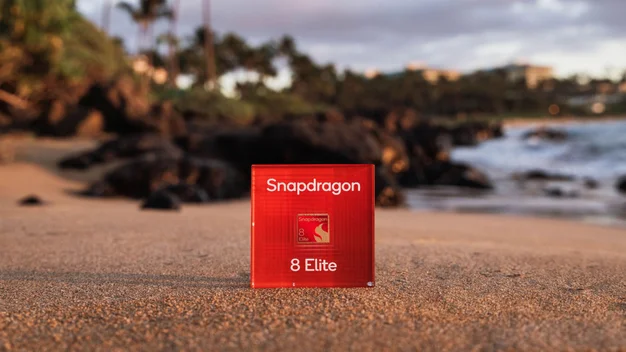
Snapdragon 8 Elite chipset in a box, sitting on a tropical beach
Qualcomm announces Snapdragon 8 Elite platform with Oryon CPU and much-improved power efficiency – here’s why I’m not thrilled
At its annual Snapdragon Summit in Maui, Qualcomm finally put to bed the discussion about what its new flagship chipset will be called by unveiling the Snapdragon 8 Elite. This new smartphone System on Chip (SoC) has plenty of flashy features and impressive benchmarks to talk about, which I’ll get into below, but my first reaction was to think back to 2021.
A little under three years ago, I was covering the latest chipset from Qualcomm and discussing its new name. It was the Snapdragon 8 Gen 1, heralding a new naming system that was designed to demonstrate a clear hierarchy among Qualcomm’s increasingly cluttered lineup of mobile platforms. Things looked good when it was succeeded by the Snapdragon 8 Gen 2, and then Gen 3, but somewhere in the mix, the message of clarity was lost, with the likes of the 7s Gen 2 and 8 Plus Gen 3 muddying the waters.
And now we have the Snapdragon 8 Elite, which could either be a grand finale for the 8-series ahead of the Snapdragon 9 Gen 1 launching next year, or yet another tier in the increasingly convoluted Snapdragon family. Before we get too into the weeds with my concerns, let’s go over what exactly the Snapdragon 8 Elite is and what new features it brings to the table.
also:EB-BS928ABY Battery for Samsung Galaxy S24 Ultra
Snapdragon 8 Elite: What’s new?
The Snapdragon 8 Elite appears to just be the Snapdragon 8 Gen 4 by another name. It’s a top-of-the-line flagship mobile chipset that will likely be the most sought-after platform for many of the biggest phones of 2025. The name change is no coincidence, either, as it uses a version of the Oryon CPU that features in the Snapdragon X Elite PC platform.

>>>>BLPA25 Battery for OnePlus 12 5G
The Adreno GPU is also getting an upgrade, with a new sliced architecture, 12MB of local memory and, in a first for mobile, support for the Unreal Engine 5.3 and the Nanite Virtualized Geometry system. According to Qualcomm, the new GPU will deliver performance up to 40% better than the Snapdragon 8 Gen 3, with 35% improvements to ray-tracing and up to 40% better power efficiency.
Rounding out the chipset is the improved Hexagon NPU (Neural Processing Unit), which handles all things AI. This upgraded NPU is said to deliver 45% improvements to both performance and performance per watt, compared to the Snapdragon 8 Gen 3, making the multimodal Gen AI more adept and efficient at addressing your queries. Qualcomm’s AI engine can also now accept much longer token inputs – examples used were entire book chapters or technical documents – allowing it to digest more complex tasks.

The AI upgrades carry over to photography, too, with the AI Image Signal Processing (AI-ISP) capable of “limitless” segmentation, splitting images into over 250 separate layers (that still sounds to me like there’s a limit…) and adjusting each one individually. It also claims to be able to capture and replicate natural skin tones in even the most challenging conditions – though we’ll have to see how that pans out when we test phones that run on the Snapdragon 8 Elite. Speaking of which…
Snapdragon 8 Elite: What phones will use it?
As part of the announcement, Qualcomm teased several manufacturers that would soon be incorporating the Snapdragon 8 Elite in their upcoming smartphones. Brands such as Honor, Motorola, OnePlus, Oppo, Samsung and Xiaomi are all poised to release devices powered by Snapdragon 8 Elite in the “coming weeks”. Unless certain release schedules are drastically different to previous years, weeks might be a stretch, but here are a few that we will likely see within the next few months.
Honor Magic 7 series – This one is dead cert because Honor took the stage at the Snapdragon Summit to announce that its upcoming Honor Magic 7 series will make use of the 8 Elite. The follow-up to the Honor Magic 6 Pro is launching in China on October 30th.
OnePlus 13 – The OnePlus 13 has long been rumoured to be the first phone to use 8 Elite but Honor has beaten it by a single day. The OnePlus 13 has a launch set for Halloween, and once again you can expect it to come to the NZ in the first couple of months of 2025 – the OnePlus 12 arrived in late December, for reference.
Samsung Galaxy S25 Ultra – In the past, Samsung has used Snapdragon for all of its S-series flagships, but this past year, only the Galaxy S24 Ultra used it, so it’s anyone’s guess what they’ll do next year. Either way, the S25 Ultra is all but certain, and this will likely launch towards the end of January 2025.
Xiaomi 15 series – While rumours have it launching in China as soon as 23 October.Last year, the Xiaomi 14 launched in Europe at the end of February, so we can expect the 15-series to follow a similar schedule in 2025.
Snapdragon 8 Elite: What’s the problem?

The fact that the Snapdragon 8 Elite exists is not a problem – it’s a natural upgrade to the 8 Gen 3 and has plenty of exciting features that could make next year’s flagships formidable in both the performance and power efficiency stakes. My issue is that Qualcomm’s attempts to keep naming simplified – to a point where a layperson could easily parse the lineup and quickly understand whether a chipset was better or worse than those around it – have been abandoned in less than three years.
It’s messy enough right now but I’m wondering what’s going to happen next year. Will we see a Snapdragon 9 Gen 1 join the fray? Or will it be Snapdragon 9 Elite, Snapdragon 8 Elite Gen 2 or Snapdragon 8 Plus Elite? Will we see a slightly underclocked Snapdragon 8s Elite? It’s exhausting even thinking about it.
Admittedly, this likely won’t be much of a problem for a lot of people, as not everyone pays close attention to exactly what chipset is tucked away inside their new phone, but I still find this kind of obfuscating setup to be inherently anti-consumer. When the options are so chaotically laid out, how is anybody supposed to easily assess them and make an informed decision?
Regardless of my feelings on the Snapdragon naming systems, I’ll be getting my hands on all of the above-mentioned devices soon, so be sure to check back in then to see if Qualcomm’s claims about the Snapdragon 8 Elite hold up.